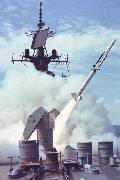Would you like to make this site your homepage? It's fast and easy...
Yes, Please make this my home page!

AN/SPS-48C Radar System Overview


This is a brief introduction to the AN/SPS-48C Radar Set.
Note: AN/SPS-48C has been upgraded on most ships to AN-SPS48E
The principals behind the radar remain the same.
The radar is a 3 dimensional display system that provides radar operators with range, azimuth and height aircraft target information. This is accomplished by using a frequency-scanning antenna, which emits a range of different frequencies in the E/F band (10cm). Height information is generated using the following philosophy - If the transmitted frequency rises then the beam travels down the face of the antenna; If the transmitted frequency falls then the beam travels up the face of the antenna. The radar set is designed so that it keeps track of the frequencies as they are transmitted and then detects and converts the returned frequencies into 3D display data. The radar also provides accurate height data despite the fact that the antenna does not have mechanical vertical position elements. This is accomplished by factoring in the effects of pitch and roll of the ship, which changes the transmitted frequency accordingly. The ship's gyro system provides the radar set with this pitch and roll data.
The AN/SPS-48C Radar system is a complete system including - Transmitter, Receiver, Computer (Radar and Automatic Detection and Tracking), Frequency Synthesizer and Height Display Indicator.
The following is a list of typical equipment repaired by a AN/SPS-48C technician.
Antenna Group consists of;
- Radar Antenna
- Reference Antenna
- IFF Antenna
- Antenna Pedestal
Transmitter Group consists of;
- RF head power supply
- Final RF power amplifier
- Final PFN
- Driver PFN
- Radar driver modulator
- Radar final modulator
- Relay Assembly, Type 4
- Trigger amplifier-thyratron bias power supply
- Trigger generator assembly
- Second RF power supply
- Driver RF amplifier
- Second RF modulator
- Second RF amplifier
- Second stage meter assembly
- Electrical equipment cabinet transmitter group
Dummy load (high power water cooled)
Waveguide Switch
Frequency Control group consists of;
- Frequency control synthesizer (synthesizer no. 1)
- Synthesizer power supply
- Fequency control synthesizer (synthesizer no. 2)
- 4 watt amplifier
- Temperature correction synthesizer (synthesizer no. 3)
- Frequency converter
- First RF modulator
- First RF series regulator
- Electrical equipment cabinet frequency control group
Receiver Group consists of;
- IF. amplifier assembly no.1, type 2
- Storage assembly no. 1
- Storage assembly no. 2
- Receiver electrical equipment cabinet
Electronic command signal programmer;
- Signal Data Converter (SDC)
- Scott-Tee power supply
Data Stabilization Computer (DSC)
Moving target indicator (MTI) group consists of;
- Video data processor
- MTI power supply
- MTI receiver
- MTI receiver plate
- Delay line set
- MTI canceller
- MTI canceller IF. plate no. 1
- MTI canceller IF. plate no. 2
- MTI canceller IF. plate no. 3
- Delay line assembly
- MTI electrical equipment cabinet
- MTI Control Box
ADT (Automatic Detection and Tracking) processor group consists of;
- ADT processor
- ADT electrical equipment cabinet
- 5-volt power supply
- AN/SPS-48 level shifter
- AN/UKY-20 level shifter
- Gate storer no. 1
- Gate storer no. 2
- ADT memory unit
- Video correlator no. 1
- Video correlator no. 2
- ACD processor no. 1
- ACD processor no. 2
- Timing and control generator
- Synchronizer data generator
- Video correlator no. 2
- AN/UKY-20 input/output control
- ADT control box
Radar set console group consists of;
- Radar set console type 1 (RSC)
- RSC wired cabinet, type 1
- RHI high voltage power supply
- RHI synchronizer
- Azimuth height converter
Typical Test Equipment used to repair the AN/SPS-48C consists of;
- 100 MHz Oscilloscope
- Digital Mutimeters
- Pulse Generators
- Signal Generator (to the microwave range)
- Micrometer Cavity (frequency measurement of the radar)
- Time Delay Reflectometers (TDR) (for finding opens in long lines)
- Power Meters (output power of transmitter)
Other skills a typical AN/SPS-48C technician has to maintain the system includes;
- Knowledge of Dry Air Systems
- Knowledge of basic plumbing skills to keep chill water system operating
- Working Aloft on the Radar tower
- Basic Knowledge of hand tools (including a torque wrench, non-magnetic tools)
Consider the following repair - Driver Stage Amplitron Replacement;
- Shut down all radar power systems
- Shut down dry air to the wave guides (dry air is used to prevent arcing in waveguides)
- Bleed dry air pressure
- Shut down chilled water system (used to cool RF windows in the Amplitron)
- Isolate chilled water from the transmitter
- Discharged Pulse Forming networks
- Disconnect Electrical Connections to the tube
- Disconnect the air, water, mechanical connections to the frame
- Carefully liftout the 75 pound Amplitron tube out of the frame
- Inspect the cathode insulating oil cavity
- Replace insulating oil
- Reverse preceding steps to reinstall tube
When I first reported aboard the USS John F. Kennedy this rough procedure used about 4 to 5 hours using a team of 3. After 4 years that time was cut to 2.5 hours using a two-man team.
Return to Helverson's WebSpot Home page
Charles E. Helverson's Mailbox
![]()